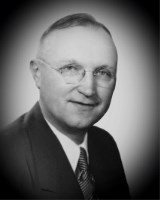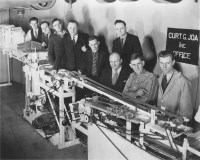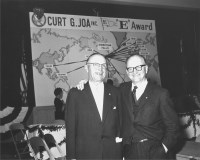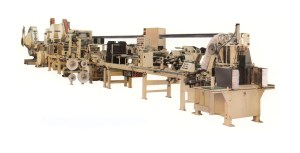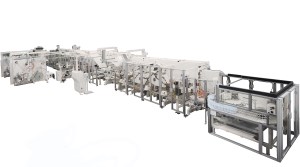Upon arriving to the United States, Mr. Joa’s first business was to provide farmers an errand-running service. He started with one truck and quickly expanded to three trucks in one year. He sold the business and was able to put $1,000 into savings.
1903
Our founder, Curt G. Joa, was born on August 8 in Mannheim, Germany.
1924
On August 11, at age 21, Joa left Germany for the United States. He boarded the S.S. Arabic from Hamburg, Germany and headed for New York where he began his new life in America.
1925
Mr. Joa’s first engineering job was at the Bucyrus Erie Co. in Evansville, Indiana. He later transferred to their plant in Milwaukee, Wisconsin before taking a job at the A.O. Smith Co.
1925
Mr. Joa married Martha Frieda Rydberg. Eventually, the couple had three children, Curt Jr., Anna Mae and Ruth Joyce. Later, Mr. Joa and his family moved to Manitowoc, WI where he worked for the Mirro Aluminum Co. as a tool and die designer.
In 1932, Joa established an engineering-consulting company bearing his name.
1930
Mr. Joa opened an office as a freelance efficiency-engineering consultant. He thought he could help companies streamline their processes and become more efficient. Soon, he was given an opportunity to design an automated process to produce sanitary napkins. After demonstrating a working model of part of the process, he was commissioned to make the first machine on October 8, 1931.
1932
Mr. Joa applied for his first patent.
1934
Curt G. Joa, Inc. received its first patent, U.S. Reg. No. 1,957,651 for an end-fold mechanism for sanitary napkins.
1935
Mr. Joa and his family moved to Sheboygan Falls, Wisconsin where he continued to build machinery. He also acquired a failing woodworking company by the name of The Jenkins Co.
In the 50s, Joa introduced its first production machine, the dual lane Model 400J Sanitary Napkin Machine. Features included a fluff-filled pad, a non-woven overwrap, a poly-bead longitudinal seam, automatic stacking and cartoning and a guaranteed production rate of 400 napkins per minute.
1942
Joa merged his two companies together, ultimately employing nearly 280 workers.
1942
The company supported the war effort by producing various parts for the U.S. Navy. Even during this time, Joa engineers continued working on improvements to the sanitary napkin machine. This led to developments such as pin discs for pulp fiberization, Joa Patent No. 2,510,229, and a finger chain stacker, Joa Patent No. 2,254,291.
1950
Along with the manufacturing branch, Joa’s business included a farms division. As part of that business, he invited young men from Milwaukee up to Sheboygan Falls during the summer to work on those farms. One of these boys, Jim Lovell, became an astronaut and Spacecraft Commander of the infamous Apollo 13 flight.
1953
Curt G. Joa, Inc. opened a plant in Ft. Pierce, Florida. It later moved to Lake Wales where it was located until 1965.
1957
Mr. Joa sold the Jenkins portion of his business to Karl Kohler, creating the Kohler-Joa company. Mr. Joa still held interest in the company, but he wanted to focus on other ideas.
On February 22, 1966, Curt G. Joa, Inc. received the “E” Award for Excellence in Exports from the U.S. Department of Commerce.
1960
On November 15, a ground-breaking ceremony was held to mark the beginning of construction of the new 18,000 square feet building at the current Sheboygan Falls site.
1961
Mr. Joa introduced a profit-sharing plan to his employees with this opening statement: “There is always room here for an ambitious employee who has the spirit, talent and a conscience to contribute his share without constant supervision.”
1962
Joa's first baby diaper machine, the Model 300 Insert Diaper Machine, is created.
1965
Mr. Joa relocated the Florida division of the company to a new site in Boynton Beach. This factory concentrated primarily on the design and manufacturing of machines for sanitary napkins and insert diapers. Meanwhile, the Sheboygan Falls facility concentrated on the new plastic-backed diaper machinery.
1968
The Model 83 Wingfold Baby Diaper Machine, with a design speed of 250 diapers per minute, was born. The development of pressure sensitive hot melt adhesives was of landmark importance in the evolution of these products and machines.
The 70s saw significant advancement, as Joa’s sales expanded to six continents. The decade also saw advancements in raw materials, which led to sophistication in product design. Introduction of tape closures and leg elastics for diapers and poly inserts, and peel strips for napkins, spawned the Joa Model 85E and the JOA Model SN300 machines. As the wingfold adult diaper market developed, specialized machinery also developed for these products.
1972
The “E” Star Award for Exports was awarded to Curt G. Joa, Inc. for continuing to export over 50 percent of its machinery sales.
1982
The company responded to the production demand in the baby diaper industry with the J5 electronic line shaft machine, capable of 500 products per minute. On a parallel path, the SN500 sanitary napkin line offered production rates up to 650 products per minute. The Model FWS500 served as a universal upgrade to fold, wrap and stack all designs of feminine care products. The first adult incontinence products machinery was developed for fully-contoured, elasticized diapers in three sizes.
1988
An 83,000 square foot (7700 square meters) assembly and testing facility with secure, fully-equipped testing bays was added to the main plant.
1991
An additional 80,000 square feet (7,400 square meters) were added to the main plant.
1992
One of this decade’s challenges was to design new machines that had built-in flexibility to allow the machines to follow product evolution. Joa’s engineering developed these new process requirements while applying the new technology to existing machines as retrofits. Upgrades to diaper and napkin production machinery included:
- Drum forming of 3-D fluff cores
- Tension controlled auto-splice material unwinds
- Online-laminated back-sheet assemblies
- Stretch waistbands
- Hook and loop diaper-fastening systems with and without stretch
- Elastic side panels for napkins and light incontinence products and high-speed stacking systems
The 90s also saw significant advancements in production speeds and efficiencies across the complete range of standard Joa lines for baby diapers, feminine napkins and light and heavy adult incontinence products.
From 1994 through 1999, Joa developed and introduced its line of machinery to produce baby training pants and adult protective underwear. These specialty machines continue to evolve as these pants-type products continue to improve.
1995
A new off-site facility with all necessary capabilities for the design, development and testing of highly confidential projects was constructed.
1997
Curt G. Joa, Inc. expanded its machining and fabrication facilities by 45,000 square feet (4,200 square meters), providing space for the addition of numerous CNC machining centers. This addition facilitated the company’s ability to manufacture and fabricate custom components quickly and more efficiently.
1998
Our adult protective underwear machine, capable of producing disposable, elasticized adult-incontinence underwear, was developed and successfully tested.
1998
In November, Mr. Joa passed away, and his wife passed shortly after in January of 1999. In their estate planning, the succession and independence of the company was secured through the establishment of a family trust that holds all company shares.
The first decade in the new millennium brought an array of new technologies, including two new drive platforms, available for application in our equipment.
2002
The Joa J4-MV, designed for speeds up to 300 meters per minute, was created to provide a performance value and technology bridge between the existing J4-S servo and the J4-M mechanical platforms.
2002
Curt G. Joa, Inc. consolidated, and the plant in Boynton Beach, FL closed.
2003
Curt G. Joa, Inc. opened a new European office located in Andernach, Germany.
2004
The company added 69,000 square feet of assembly and testing space. The extra space provided additional larger and secure machine-testing bays.
2005
Computerized water-jet cutting technology is added to the fabrication and machining facility to provide quick and efficient turnaround of parts cut from everything from heavy steel plate to very thin sheet metal.
2005
The Joa J20 line of machines for high-speed, high-efficiency production of light incontinence and feminine hygiene was developed and introduced into the market.
2006
A more defined and dedicated research and development team was put into place to keep the company on the cutting edge of technology in both its traditional business but also to enhance the more custom machinery designs for special products that became prominent.
2007
The J8 machine platform is developed.
2007
Curt Joa is inducted into the Paper Industry International Hall of Fame as a Founder/Research and Development/Entrepreneur.
As we pass the half-way point of the current decade, Joa continues to grow and develop new technologies. And as Joa grows, so does its world-wide presence.
2011
The Andernach, Germany office closed.
2011
Joa announced new partnership with German manufacturer, Bikoma.
2011
European sales relocated to Hamburg, Germany.
2012
The J8T-B high-speed diaper machine platform is developed.
2015
Joa purchases the remaining Bikoma shares, officially making it a "Joa Company". This expands Joa's presence even further, allowing for faster response times and local support throughout the world.
2016
The J7I-AP adult pant machine debuts. Its design allows Joa to serve customers in new markets throughout the world.
2017
Joa celebrates 85 years of delivering custom, high-speed solutions to the disposable hygiene industry
2018
Rick Michaletz announced as new company president, as former president Gene Kiela II officially moves into role as chairman of the board.
2018
The Joa European Technology Team (JETT) announced as Joa's newest European branch.
2019
Curt G. Joa competed for the IDEA Equipment Achievement Award while in Miami Beach, Florida. The Infinity Roll was nominated as one of the best new equipment innovations of 2019!
2020
The Joa East Asia office announced as Joa's newest Asian branch.



